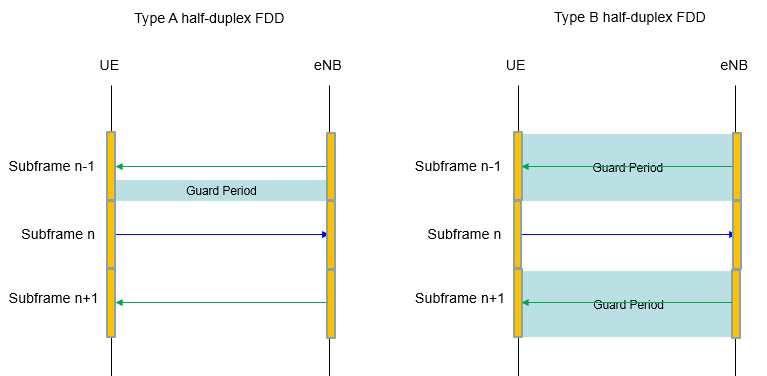|
4G/LTE - Duplex |
||
|
Half Duplex
As you may know, 'Duplex' means a communication system that allows bi-directional communication (both transmission and reception). It means it is not Reciever only nor Transmission only communication. Then what 'Half' mean here ? 'It allows 'Duplex communication' but with some limitation. What kind of limitation does it mean ? In this case, the limitation is 'it does not allow bidirectional communication at the same timeslot', meaning 'it does not allow simultaneous bidirectional communication'. In other words, it can do transmission only at one time and do reception only at another time. (Walkie-Talkie with the push-to-talk button would be one of the typical example of Half Duplex).
What does it mean by Half-Duplex in LTE FDD case ? It is originally designed for Full Duplex and probably more easier to operate in Full-Duplex mode. Actually FDD Half-Duplex was discussed even from the initial LTE design, but hasn't gotten much attraction for a long time. However, recently as IoT /M2M /MTC /Category 0 /Category M/LTE-M over LTE becomes a hot topic, FDD Half-Duplex is coming back to surface. This kind of application (IoT/M2M/MTC) does not require high throughput but require very efficient (low) energy consumption. With Half Duplex, UE (terminal device) may save a lot of energy by turning off Transmitter or Reciever when it is not used. With point of eNB perspective, there are couple of things to be considered to implement Half-Duplex meaning there is no Downlink/Uplink simultaneous transmission. It should be careful about PDSCH/PUSCH scheduling so that there is NO such a case as follows.
Also eNB has to consider following two modes of Half-Duplex mode defined in 36.211 (ts_136211v120700p.pdf) 6.2.5 Guard period for half-duplex FDD operation as described below.
For type A half-duplex FDD operation, a guard period is created by the UE by
NOTE : Type A Half-Duplex is defined in Rel 8, but not much used in real deployment (as far as I know, not used at all)
For type B half-duplex FDD operation, guard periods, each referred to as a half-duplex guard subframe, are created by the UE by
NOTE : Type B Half-Duplex is a kind of newly defined mode for Category 0 or Cat-M. Since Category 0 is rarely adopted in real deployment, major application of LTE-M would be Cat-M.
This mode of operation would be illustrated as below. As you see in this illustration, in Type A Guard period is very short (a fraction of one subframe) right before Uplink transmission, but in Type B Guard period takes a full subframe both before and after the start and end of uplink transmission. This wide guard period would make hardware design easier and simpler.
Reference :
[1] LTE Radio Access Part V: TDD, half-duplex FDD (YouTube)
|
||
